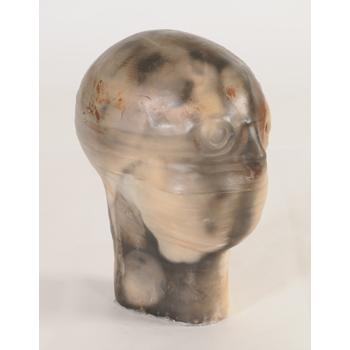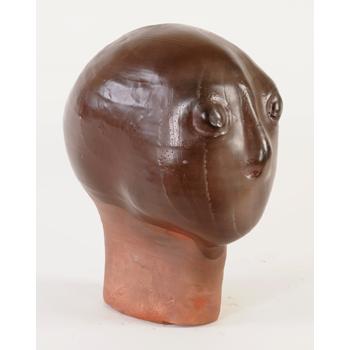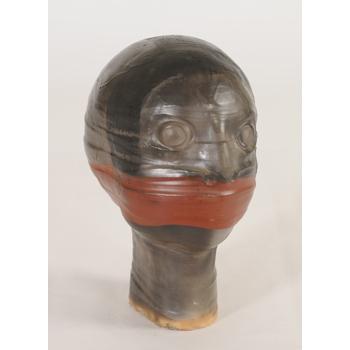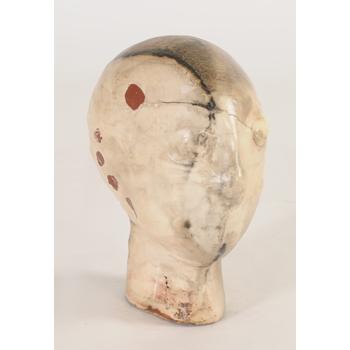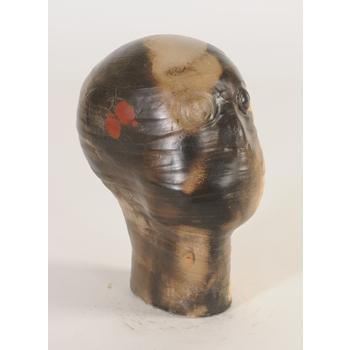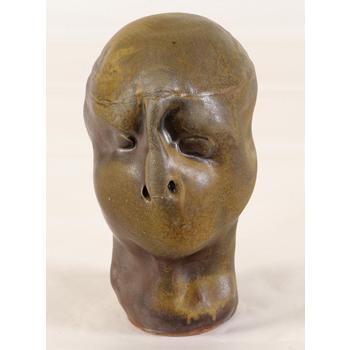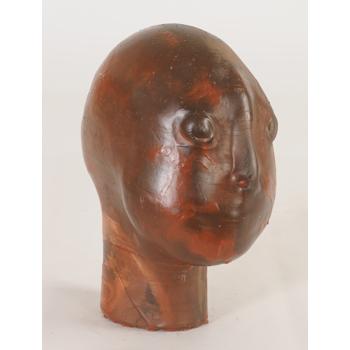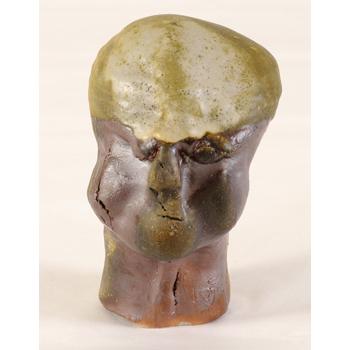Mary Bowron
(1933-2017)
Mary Bowron is a ceramic artist from Boyds, Maryland with a truly compelling story. Her body of work, primarily heads, is part of the Silence Witness Series that Bowron produced over many years. Each piece is approximately 10 inches tall and they were created by a variety of clays and glazes. The pieces are best shown and best tell the story when arranged in a group. This is a particularly compelling collection because of the story behind it. Having grown up in the south during a time of racial tension and unease, the heads reflect Mary’s passion for human rights and equality. In speaking of the heads, Mary has said, “all have no mouth for fear of speaking what they say and hear. This fear is a plague on us all.” She also refers to the heads as a “crowd of silence and fear”.
It is a powerful body of work. In 2010 the ceramic heads were shown at an Amnesty International Human Rights Art Festival in Silver Spring, MD exhibit called “Silent Witness.” Her work has been shown at the Washington County Museum of Fine Art as recently as 2014. The John Michael Kohler Arts Center has accepted a major gift of Mary's heads numbering more than 150. Mary’s work has also been placed at the American Visionary Art Museum (MD), Hood College (MD), University of Reno (NV), Washington County Museum of Fine Art (MD), LaGrange Art Museum (GA), George Mason University (VA), Gregg Museum of Art and Design (NC), Alverno College (WI), University of Wisconsin-Sheboygan, and St. Norbert College (WI).
Mary’s bio, written by Mary in collaboration with her daughter Ellen, tells the story well:
Mary Bowron was born in 1933. She will tell you, she was first drawn to play in the native clay of the South as a very young child. She remembers clearly the tactile and visual characteristics of the soil where she spent her youth; in Alabama, in Mississippi and Louisiana. Her visceral sensitivity and attraction to the mineral earth and her empathy for its creatures and the human experience is a consistent thread throughout her work.
Mary’s formal education in the arts was incidental to her secondary schooling. Her creativity and skill was evident as a child, yet was not cultivated or particularly encouraged. She recalls a fourth grade teacher who was skilled in Chinese brush painting. To her eye, Mary says that Asian ceramics always struck her as more beautiful in form than any other type of pottery. Her own work reflects her affinity for this aesthetic.
Mary has been working with clay consistently since the early 1960’s when she lived in southern California. She gave pottery a try as a young mother seeking an outlet for her creativity. She set her wheel to work in the dining room of her house, firing her wares at the Pot Shop in Venice Beach.
Her journey has led her from all manner of functional wheel-thrown tableware; vases, lamps, bowls, teapots, tea bowls, and plates; to innovative methods of slab-formed vessels, tile-making, sculpture of birds and horses, sculpture depicting clustered human forms, through to her decades-long creation of the Silent Witness heads. Her kilns have been gas-fired, wood-fired anagama and pit-fired. She has worked both in California and since the mid-Sixties in Maryland.
Her natural curiosity and inclination towards experimentation leads Mary to any medium that might produce the effects she sees in her mind’s eye, where nothing is off limits. Whether clay, paint, paper, or bronze, copper-plate etching, wax, mono-prints, photography or even the natural environment, Mary feels compelled to create. Her collection of works on paper is extensive and stands on its own. She would tell you that she will never have enough time to bring all of her ideas to life; she will never run out of things to say.
“You must not always choose, ‘pretty.’” Mary’s work frequently depicts humans and animals in both their most glorious form and their most vulnerable and wounded. She has typically depicted horses, birds, fish, plant-life and the human form in this message. Someone once told her after viewing her work, “It is surprising to learn who is really suffering.”
Over time, Mary increasingly mixed and prepared her clay bodies on her farm in Boyds, Maryland. She amassed an extensive collection of wood ashes over the years from many sources and many different types of wood that she uses to formulate unique glazes.
She is a compulsive information gatherer, collecting a deep library of books, never failing to stop and meet an artist, never fearing a failed experiment and having a singular focus on her processes. From these and a universe of dreams, ideas, experiments and experiences, Mary creates.
